Before and after photos on gum recession from a toothbrush causes sensitivity performed in our Gum Disease Treatment office.
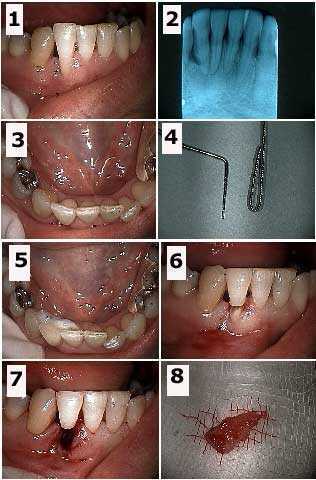
Treatment of severe gum recession in a mandibular lateral incisor tooth. How to pictures. The tooth root was extracted and a temporary teeth splint was placed using the coronal portion of the extracted tooth. This patient had sensitive gums in this area and the Periodontist determined that periodontal gum surgery – a free gingival graft – would not help because of the amount of bone loss. 1) – 3) Initial photos and periapical radiograph x-ray. 4) The wire used for the teeth splint is placed next to a periodontal probe to give an idea of its size. The wire is doubled to prevent the tooth from rotating around it after placement with dental bonding material. 5) This photo shows the dental splint after being glued to the lingual surfaces of the adjacent teeth #’s 25 and 27 using teeth bonding material. 6) Initial drilling preparation through the mid-length of the tooth. 7) Following extraction of the tooth root. 8) The extracted tooth root. This patient has already been through two rounds of scaling and root planing with the dental hygienist. After wound healing of this extraction site the patient had a gum graft to build up this area to improve the cosmetic dentistry result of the pontic. The patient experienced minimal gum pain from all dentistry performed. An all porcelain ceramic Maryland Bridge was subsequently placed after completion of the periodontal therapy and maintained successfully for over ten years.
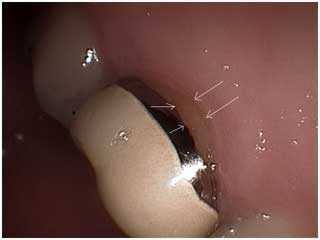
Gingival gum recession around an old dental crown. This can make the tooth very sensitive to touch, air and/or hot & cold liquids; note that this is tooth pain. This is frequently not associated with gum pain or sensitive gums because there is not associated gum inflammation. Note in this photo that the gum color is pink not red. Red gums are ususally a symptom of gum infection. Gum recession treatment depends upon the severity of the subjective symptoms and can range from: 1) do nothing and reevaluate, 2) use desensitizing agents, 3) periodontal gum surgery or 4) remaking the dental crown with or without root canal therapy. Using a toothbrush too aggressively can cause severe gum recession.
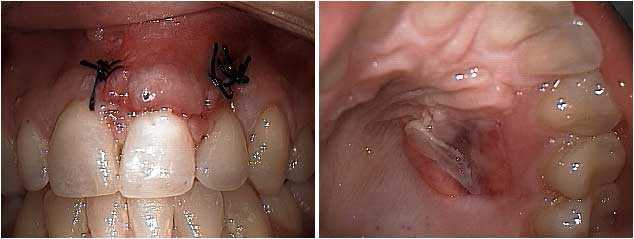
Pictures of a free gingival gum graft three days after periodontal gum surgery. The upper front central incisor tooth exhibited a lot of gum recession that bothered the patient cosmetically with minimal gum sensitivity. 1) The gingival graft is shown after being sutured in place by the Periodontist. These black sutures – stitches – will be removed in about ten days. 2) This photo of the palate of the same patient shows the donor site for the graft. A free gingival graft typically involves removing a small amount of palatal gingiva – gums – and sewing it where it is needed. It is a commonly accepted periodontal gum treatment for gum recession.
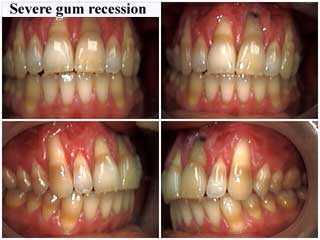
Severe gingival gum recession with mucogingival involvement on all anterior teeth. This patient sought periodontal surgery treatment for isolated areas of gum pain and general gum sensitivity. Using a toothbrush too aggressively can cause severe gum recession.
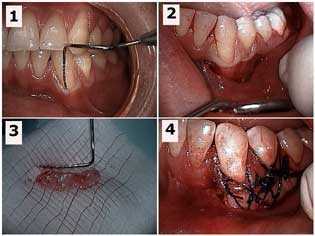
Pictures show how to perform a free gingival graft – a periodontal gum graft – on a lower left canine tooth that has significant gum recession and moderately sensitive gums. Gum recession treatment. 1) The periodontal probe is placed in the gingival sulcus – the gum pocket – showing the mucogingival defect. 2) The Periodontist makes the Initial subsulcular incision. 3) The gingival tissue is harvested from the palate that will be used for the gum graft. 4) The periodontal graft sutured in place with black stitches. Photo #1 of 4.
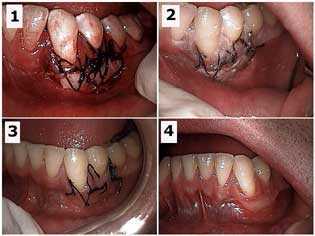
These pictures show wound healing of a free gingival graft – a periodontal gum graft – on a lower left canine tooth that has significant gum recession. Healing of the recipient site. 1) Initial gum surgery site. 2) One week post-op. 3) Two weeks post-op. 4) Seven weeks post-op. The recipient site usually feels less gum pain after the gum surgery treatment than the donor site in the palate. Photo #2 of 4.
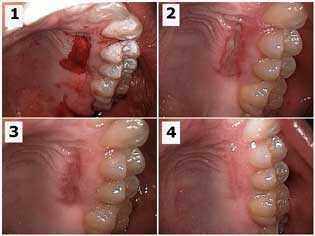
These pictures show wound healing of a free gingival graft – a periodontal gum graft – on a lower left canine tooth that has significant gum recession. Healing of the palatal donor site. 1) Initial surgical site. 2) One week post-op. 3) Two weeks post-op. 4) Seven weeks post-op. The donor site in the palate usually feels more gum pain after the gum surgery treatment than the recipient site. Photo #3 of 4.
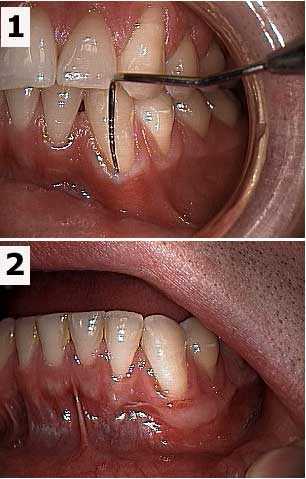
Before and after pictures of a free gingival graft – a periodontal gum graft – on a lower left canine tooth that has significant gum recession. 1) Periodontal probe in the gingival sulcus shows the mucogingival defect – the amount of gum recession. 2) This photo was taken seven weeks after gum surgery showing successful gum recession treatment. Photo #4 of 4.
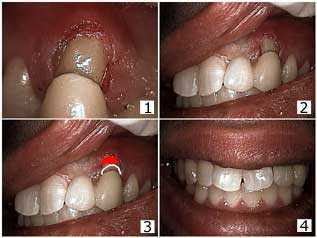
Dental bridge repair photos. 1) Fitting the bridge over the dental bonding repair. 2) The bridge was cemented with composite resin. The mesial wing was also bonded to the distal of the lateral tooth. 3) A gingivectomy minor gum surgery was chosen over a periodontal flap surgery because the patient had a low lip line and so the development of a pseudopocket with a gum flap was avoided. The red indicates where the gum line could have been after gum recession. 4) The final result photo. The patient was informed of the need for a new teeth bridge when finances allow.